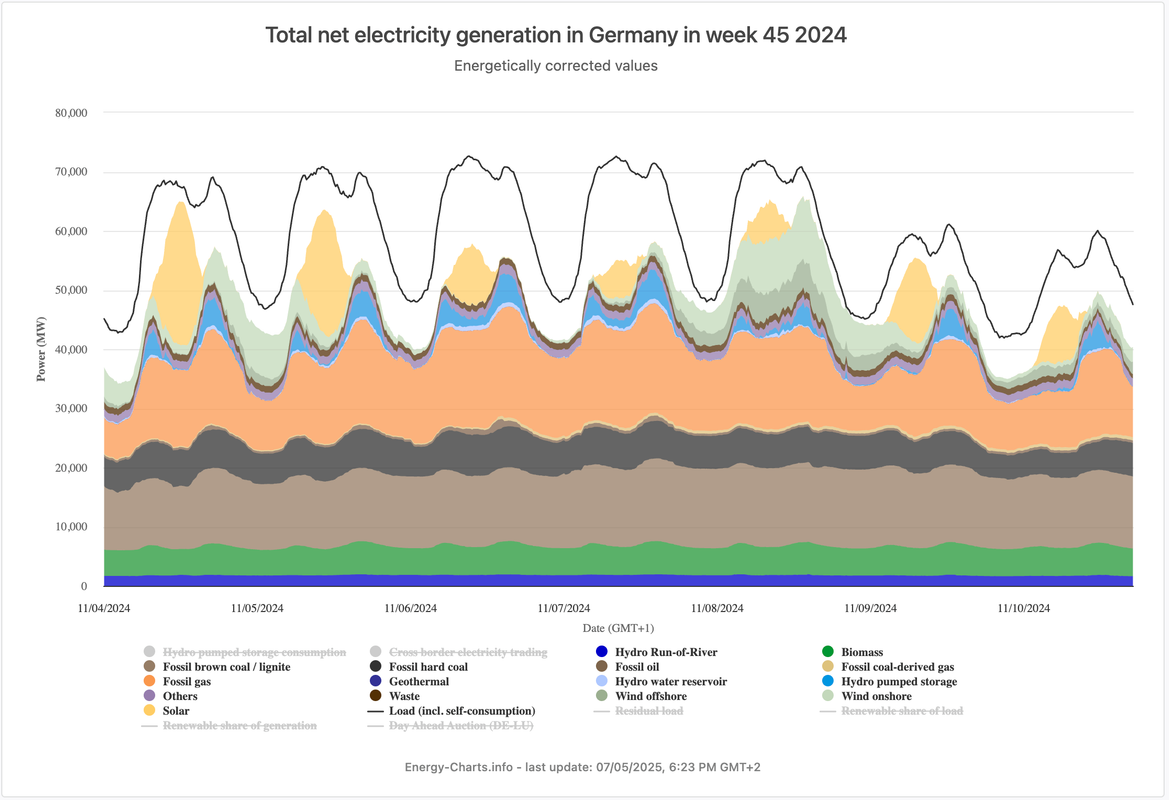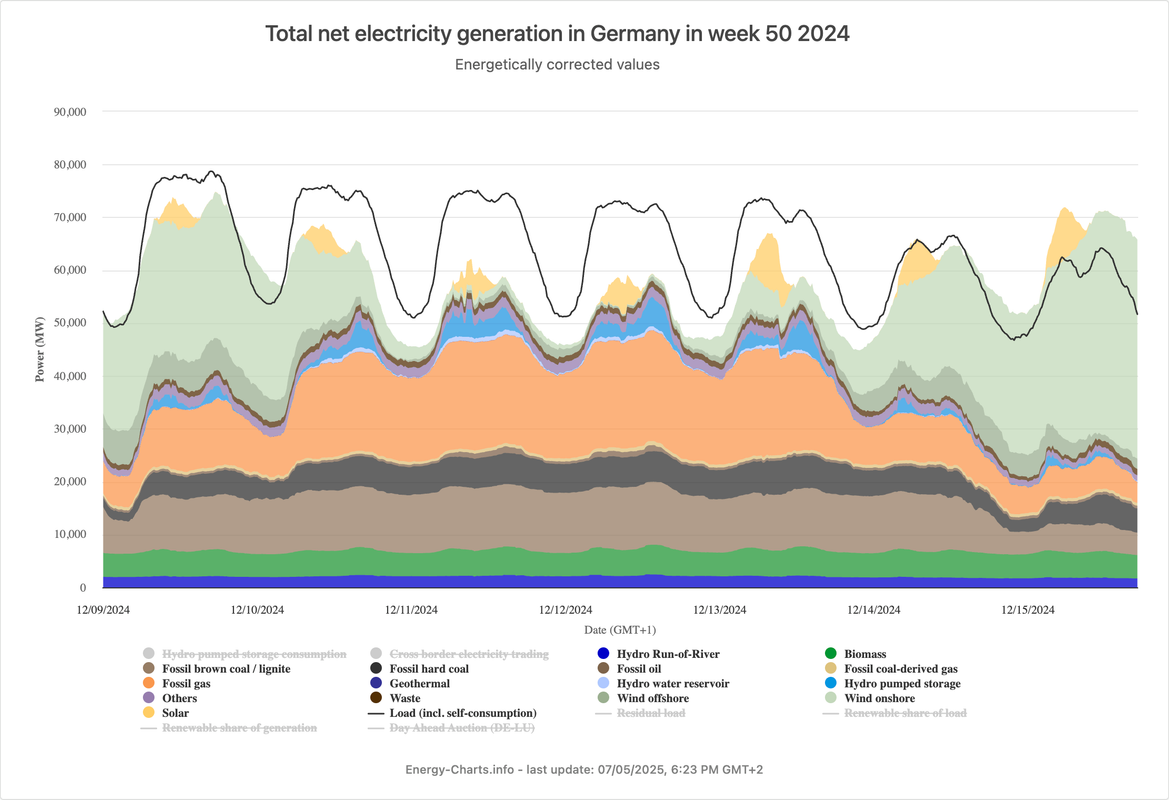Environment & Energy
Related: About this forumPlease, in my backyard...
State lawmaker wants new nuclear power plant to be located in Central New York“I’m gonna do everything to advocate that it be located in Oswego County,” said Barclay. “I think it’s a ideal location.”
This comes after Governor Kathy Hochul announced earlier in the week, that New York State is looking to build another nuclear power plant.
Barclay said Oswego County checks off all the boxes needed in order to be considered as a candidate location, including community support...
...Barclay said a new nuclear power facility would be beneficial for the state’s energy grid.
“When you have a nuclear plant, you know you can generate electricity 24/7 and it’s always going to be dependable,” said Barclay.
Blair Horner, Senior Policy Advisor for New York Public Interest Group, wants the process to be transparent and include public involvement.
“There needs to be an independent analysis as to what are the costs to the state not only directly to the cost of ratepayers and tax payers, but also the costs of not spending money somewhere else,” said Horner...
Barclay is a Repuke, but sometimes even Repukes can do the right thing. He and his constituents may not be remotely interested in the obvious collapse of the planetary atmosphere, but building the plant will slow it.
eppur_se_muova
(40,900 posts)Think. Again.
(22,456 posts)...by using a combination of the various clean energy techs that are now cheaper than fossil fuel tech, we don't have to locate large nuclear plants in densely populated areas as suggested by the OP and can simply place them where the risk to people of accidents at the plant (or during transport of the radioactive fuels) will be reduced.
More populated communities can use a mix of solar, wind, and energy storage, while heavy-load industries such as data processing (yuck), steel and concrete industries, etc, can be located outside of the residential areas to take advantage of the heavy energy output of nuclear.
We're gonna need every tool in our belt to overcome the incredibly careless greed of the fossil fuel industry.
NNadir
(37,233 posts)...expensive and land and material intensive and thus unsustainable. Their intrinsic lack reliabilty makes them dependent on fossil fuels, despite all the efforts of hydrogen liars to claim it can or should be or worse is mase from so called "renewable energy." The trillions of dollars sacrificed on the altar of the reactionary cult of "renewable energy" has left the planet in flames.
All of the "renewable energy" infrastructure will be landfill before today's newborns graduate from college, another liability left to future generations about which our antinukes, hydrogen dopes and otherwise, could never give a flying fuck.
Oh, we have a few who pay lipservice to giving a shit, for instance an idiot who likes to cite Jim Hansen while apparently being unable to grasp even the basic undergraduate or even high school level of science and engineering.
So called "renewable energy" will never be as clean or safe or as sustainable as nuclear energy. Comparing nuclear to fossil fuel dependent junk is ethically and intellectually absurd.
Think. Again.
(22,456 posts)...as long as we keep refusing to even consider massively reducing our energy use, we will have to use every form of non-CO2 emitting energy production and storage we have, such as solar, wind, H2, etc, (please don't falsely claim these processes rely on fossil fuels, because they do not) if we have any hope of transitioning away from fossil fuels.
Nuclear has it's place in that transition, but any fool can see it is not a "be-all-and-end-all" solution.
NNadir
(37,233 posts)Dunkelflaute, during the 2024-2025 winter German coal burning festival this winter which left all of Europe pissed off at surging power rates, has become a widely used word.
Cold without wind: German ‘dunkelflaute’ brings electricity prices to crisis levels and depletes gas reserves
Subtitle
I noted other Europeans calling the German wind and solar fantasy of filth a "shit show" which of course, it was, at least for anyone with a sense of decency:
The Norwegian Energy Minister States It Bluntly: "It's an absolute shit situation."
I have no use, none whatsoever for the Magat scale lie that so called "renewable energy" doesn't depend on fossil fuels.
For the battery morons spreading this lie, I calculated how much cobalt would need to have been dug by Congolese slaves to cover just the German Dunkelfluate event some years back, in response to another uninformed apologist for the trillion dollar "renewable energy" scam that has done NOTHING, NOT A FUCKING THING to slow the rate of increase of extreme global heating events:
The Number of Tesla Powerwalls Required That Would Address the Current German Dunkleflaute Event.
(The uninformed barely literate "I'm not an antinuke" antinuke at the time loved to wax romantic about the fascist Elon Musk's Powerwalls.)
As for hydrogen, anyone trying to sell this fossil fuel greenwashing scheme by claiming that the world is so awash in so called "renewable energy" that "green hydrogen" is a thing, doesn't know a fucking thing about how much energy is wastes to make hydrogen and the fact that it is overwhelmingly made from dangerous fossil fuels.
Hydrogen stupidity is even worse than battery stupidity, and battery stupidity is already pretty bad.
These cults are useless.
Think. Again.
(22,456 posts)"...we will have to use every form of non-CO2 emitting energy production and storage we have , such as solar, wind, H2, etc, (please don't falsely claim these processes rely on fossil fuels, because they do not) if we have any hope of transitioning away from fossil fuels ." (please stop taking my words out of context).
Also, clean energy tech can't do "a fucking thing" about global warming caused by CO2 until we start building out enough clean energy tech to replace CO2 emmitting fossil fuels.
Oh, and also, H2 is only still overwhelmingly made from fossil fuels for the same reason, we are still refusing to build out enough clean energy tech to overwhelmingly make it from non-fossil fuels.
Response to Think. Again. (Reply #6)
Post removed
Think. Again.
(22,456 posts)....after all, perhaps you just overlooked the fact that CO2 is rising specifically because we are not building clean energy sources fast enough to keep up with the extreme increase of energy usage.
It's okay, a lot of people have a hard time grasping situations that require the understanding of multiple concepts at once.
But anyway, yes, CO2 is still rising due to increased energy usage so we'd better start building non-CO2 energy sources faster!
NNadir
(37,233 posts)...term for it that's become quite popular, "the Dunning Kruger Effect."
I have never met an antinuke "renewable energy will save" us fool, in particular those who want to greenwash fossil fuels as "hydrogen," thus demonstrating contempt for one of the most important sets of scientific laws, those of thermodynamics, who can look in the mirror and see Dunning and see Kruger.
They're poorly educated, every one of them, "green hydrogen" morons, "solar and wind will save us" morons, who seek to tear up thousands upon thousands upon tens of thousands of square miles of virgin land for wind turbines that operate with less than 40% capacity utilization and solar farms, requiring redundancy, that are even worse, every fucking one of them, unable to see or care that the world is burning.
There's that great cliche often attributed erroneously to Albert Einstein, "Doing the same thing over and expecting a different result is the definition of insanity."
One of the most prominent antinukes in the world, Amory Lovins, another "renewable energy will save us" asshole, spent a lot of time telling everyone that energy efficiency would reduce energy demand. This is in spite of the fact that Jevon's Paradox was first published in 1865, more than 8 decades before that poorly educated rube was born. Surprise, surprise! Energy efficiency went up and energy demand went up. And now, the fact that Jevon's paradox held despite soothsaying from a "renewable energy will save us" idiot who claimed otherwise, it's an excuse?
Advocates for the reactionary scheme of so called "renewable energy" are full of excuses, one of which is that the demand for energy is increasing. Of course, a viable energy scheme would be untroubled by this.
It's 2025. The climate is collapsing, and trillions of dollars have been thrown at solar and wind.
A "renewables will save us" idiot here - one of those arsonists complaining about forest fires who say that nuclear energy can't grow fast enough but is unconcerned about the growth of fossil fuels - who now happily resides on my ignore list, objects when I cite the data from the IEA (and ignore the soothsaying):
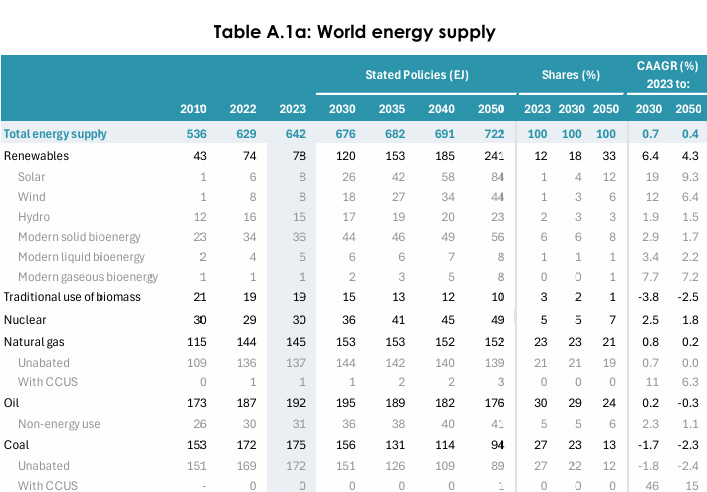
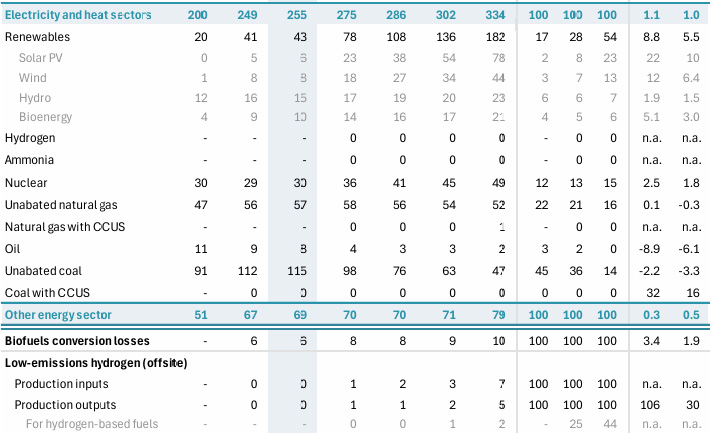
IEA World Energy Outlook 2024
Table A.1a: World energy supply Page 296.
The only thing interesting about the soothsaying, which is not qualitatively different from the last 50 years of "renewables will save us" soothsaying, is that it clearly shows the energy losses associated with treating hydrogen as if it were a form of primary energy, which it isn't. It says "by 2050" (when my quadratic model indicates the concentration of the dangerous fossil fuel waste in the planetary atmosphere will be about 525 ppm) we'll be wasting two exajoules of primary energy to make 5 Exajoules of hydrogen on a planet that will be consuming 722 Exajoules of energy.
We'll see if we get to 722 Exajoules in a collapsed and burned planet. My feeling is that 2050 will be hell, and will be so because our energy conversations bought into antinuke's reactionary fantasies about solar and wind, useless as they are.
None of this reality, that making hydrogen wastes energy, is bound to influence the "green hydrogen" idiots from offering their very, very, very stupid apologetics and in effect, promotion of fossil fuels.
As of 2023, solar and wind combined, after squandering trillions of dollars, tearing the shit out vast areas of virgin land and disrupting ecosystems, produced just 16 Exajoules of energy, this is an atmosphere of wild sybaritic cheering by energy illiterates, slightly more than half as much energy as nuclear produced in an atmosphere of idiotic criticism and selective attention.
Last year, about 7 million people died from dangerous fossil fuel waste, and that's not counting the deaths from extreme weather, facts about which no "renewables will save us" cultist will ever convince me they give a shit about these deaths, although they never tire of carrying on stupidly about so called "nuclear waste" which has a spectacular record of not killing anyone.
They don't give a shit about fossil fuels. Their excuses "energy demand is rising" are fucking intellectually and morally insipid, beneath contempt really. There isn't enough land or metal or mines on this planet to bring that crap to even a few hundred exajoules, and an effort to do that would result in an unprecedented environmental tragedy even greater than the one we're experiencing right now after decades of hearing about some putative future "renewable energy" nirvana. The "renewable energy will save us" cultists are a part - a big part - of the problem and have not a clue about the disastrous moral or technical implications that their ignorance has exacerbated.
Have a nice evening.
OKIsItJustMe
(21,703 posts)
IEA (2025), Global Energy Review 2025 (Page 34, CO₂ total emissions and CO₂ per capita emissions by region, 2000-2024), IEA, Paris https://www.iea.org/reports/global-energy-review-2025,
Licence: CC BY 4.0
Somehow, US emissions have been going down in the United States since 2000. Is it because of all of the nuclear plants we’ve been bringing on-line?
John ONeill
(83 posts)...have gone down, admittedly from a very high start point (the big Anglosphere countries, Canada, USA, and Australia, had CO2 per capita matched only by a few oil sheikdoms.) The main reason, though, is the replacement of coal by gas, which puts out about half the CO2 per watt. It's also much cleaner for particulates and sulfur, so the fumes kill and sicken fewer people. It's still a dirty fossil fuel though - the nitrogen oxides from burning it are also toxic, while methane, which escapes all along the supply chain, is a much more powerful greenhouse gas than CO2, and probably just as bad over the short term. The industry claims only 1-2% fugitive methane, any more than 3-4% would make gas as bad as coal, for the climate (over a 20 year period - CO2 stays in the air longer.)
OKIsItJustMe
(21,703 posts)Release Date: May 29, 2025 | Next Release Date: June 2026 | Full report (PDF) |
Methodology and Supplemental Content
…
Key Findings
Electric power emissions remained flat as decreasing CO₂ from coal generation offset increasing CO₂ from natural gas
CO₂ emissions from the electric power sector remained mostly flat in 2024, increasing by less than 1% (6 MMmt). Although overall electricity generation increased by 3%, or 122 terawatthours (TWh), in 2024, changes in generation sources resulted in sectoral CO₂ emissions remaining near 2023 levels. Specifically:
- CO₂ emissions from coal-fired generation decreased by 3% (24 MMmt), but:
- CO₂ emissions from natural gas-fired generation increased by 4% (31 MMmt)
- Coal-fired electricity generation fell by 3% (22 TWh), but:
- Natural gas generation increased by 3% (59 TWh)
- Solar generation increased by 32% (53 TWh)
- Wind generation increased by 8% (32 TWh)
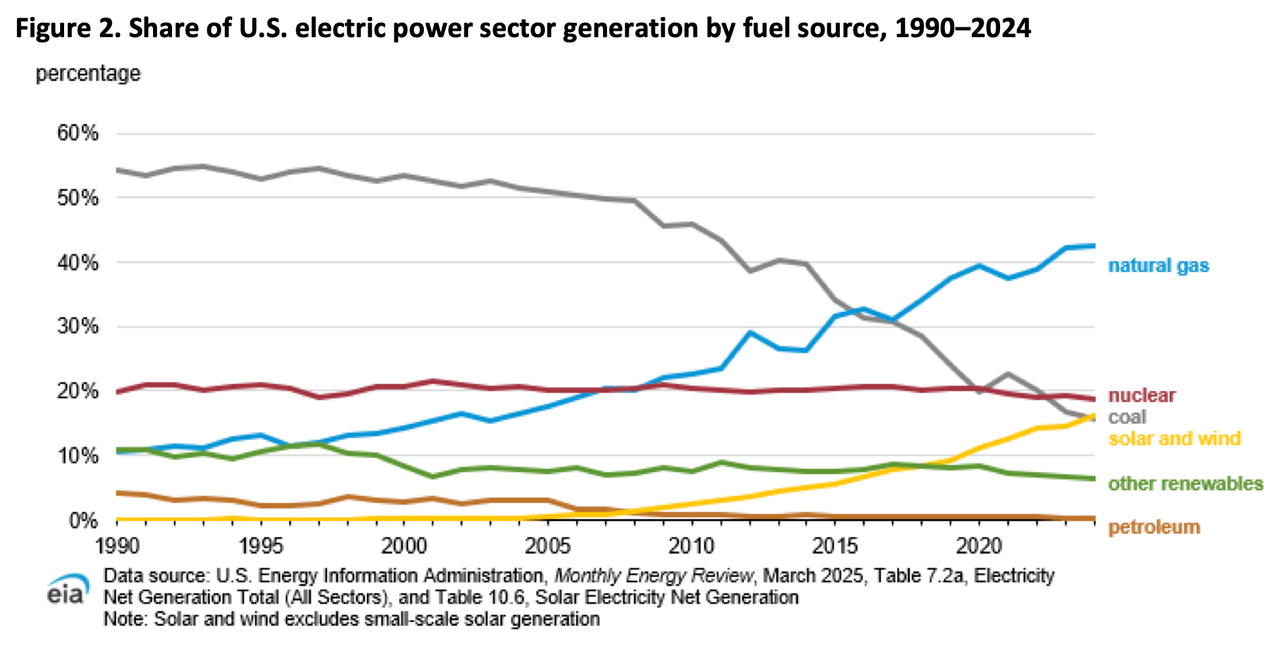
(As you suggest) early gains came from closing down coal plants and opening gas-fired plants, and this continues to be a significant contributor.
However, please pay special attention:
- Generation by (utility scale) solar & wind (combined) increased more than natural gas in 2024 (85 TWh -vs- 59 TWh.)
- Generation by (utility scale) solar & wind (combined) exceeded generation by coal in 2024
- The majority of the increase in total generation in 2024 (85/122 TWh) was supplied by (utility scale) solar & wind (combined.)
- Looking at the growth rate, it appears clear that generation by (utility scale) solar & wind (combined) will exceed generation by nuclear in the very near future.
All that being said, we still need to roll out new nuclear plants.
OKIsItJustMe
(21,703 posts)Science, is about making predictions. In this case, the IEA has made predictions for 2025-2027. They feel that the trend of increasing deployment of renewable energy (esp. PV) will continue.
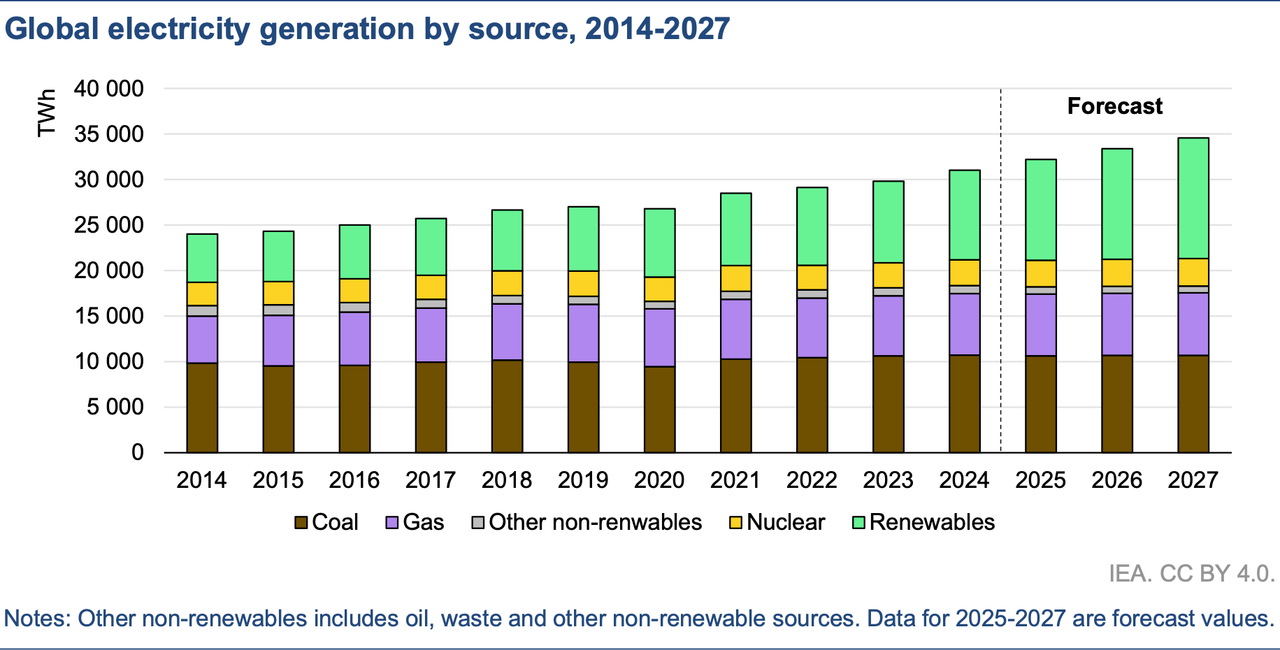
IEA (2025), Electricity 2025, (Page 51, Global electricity generation by source, 2014-2027) IEA, Paris https://www.iea.org/reports/electricity-2025, Licence: CC BY 4.0
Global electricity generation from renewable energies rose 10% y-o-y in 2024, double the 5% increase in 2023. Hydropower generation, which had declined by around 2% in 2023 amidst severe droughts in many regions, most notably in China, posted a substantial rebound in 2024, up by 4%. The increase was led by a strong recovery in both China and Europe due to higher precipitation.
At the same time, solar PV generation grew by 30% in 2024, its highest growth rate since 2017, totalling a record gain of 475 TWh y-o-y. More than half of the growth in solar PV generation came from China. Over the 2025-2027 forecast period, we expect global solar PV generation to rise by about 1 800 TWh. As a result, solar PV is set to meet around half of the growth in global electricity demand in our outlook period. The strong growth trend in solar PV is accompanied by continued expansion in wind generation, which is forecast to meet around one-third of additional global electricity demand during this period. We forecast total renewable generation to increase each year by 10% on average out to 2027, adding around 3 400 TWh globally in total.
OKIsItJustMe
(21,703 posts)Temporary periods with reduced wind and solar PV generation may put additional strain on the power system, especially if they occur during periods of high electricity demand, such as during colder winter seasons with increased heating demand, or hotter summers with higher cooling load. During these periods, power demand is met predominantly by dispatchable power plants and using various flexibility measures. These events can also lead to temporary and briefly higher prices on the wholesale markets if supply is tight. Having sufficient (low-emissions) dispatchable capacity and long-duration storage, among other flexibility options such as demand-side flexibility and interconnections, is important to effectively manage such periods.
In November and December 2024, there were several occasions in Northern Europe when combined wind and solar PV electricity generation was very low, the so-called compounded VRE droughts or Dunkelflaute events, which led to tighter supply and several hours of extremely high electricity prices on the wholesale markets. In 5-7 November and 11-12 December Germany and the surrounding regions were affected. In early 2025, on 8 January, the United Kingdom had a relatively localised Dunkelflaute that lasted for about a day. Low wind availability during the nighttime combined with interconnector unavailabilities, power plant maintenance outages and elevated electricity demand led the national energy system operator (NESO) to issue a notice due to low system margins.
All these events were managed successfully without any impact on the supply of electricity, showing the resilience of the power systems and the underlying market mechanisms. The price spikes observed during the period of a few hours only had a very limited impact on average prices but acted as important signals to incentivise flexible generators to produce more and for flexible consumers to reduce their consumption, while also facilitating the efficient import and export of electricity. Nevertheless, a comprehensive understanding of such events is important to plan accordingly as both electricity supply and demand become more weather-dependent.
John ONeill
(83 posts)... what it really shows is that there's still plenty of gas capacity to cover the entire load, when wind and solar go on holiday together. The resulting surge in emissions is partly mitigated by huge exports of nuclear-generated power from France, especially to Germany and Italy (which both banned nuclear.) Sweden, with 30% nuclear and 40% hydro, plays a similar role for the Baltic countries.
Think. Again.
(22,456 posts)OKIsItJustMe
(21,703 posts)OKIsItJustMe
(21,703 posts)OKIsItJustMe
(21,703 posts)Last edited Sun Jul 13, 2025, 09:46 PM - Edit history (1)
The recent Dunkelflaute occurrences in Northern Europe on 5-7 November and 11-12 December 2024 provide relevant case studies for understanding how well- interconnected markets with sufficient dispatchable capacity allow for a resilient system under the corresponding market price signals, even when such events affect a wider region.
Day-ahead electricity prices in Germany and parts of the Nordic countries exceeded EUR 900/MWh in a single hour on 12 December after sunset, although prices were already high during daytime, averaging around EUR 500/MWh between 07:00-15:00. Solar PV generation is typically lower during the winter season in Northern Europe, and this day was not particularly different. The solar PV capacity factor for the whole day was an estimated 0.7%, compared to the December average of 1% for the 2019-2023 period. By contrast, output from wind was substantially below its seasonal average and a temporary wind drought was observed. The average capacity factor of wind generation was 2% on this day, compared to the December average of 26% over the period 2019-2023. The day before, 11 December, had also recorded very low wind output at an average capacity factor of 3%, with prices exceeding EUR 400/MWh around 16:00-17:00.
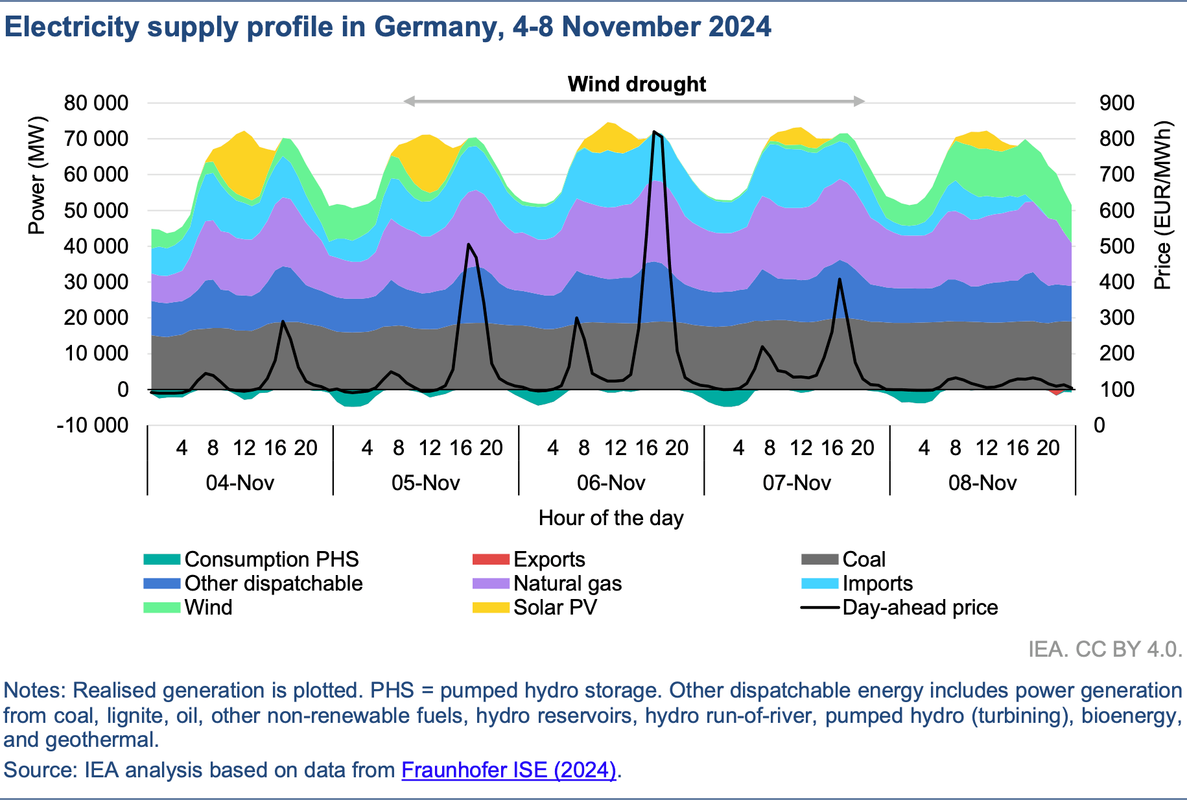
A precursor to 12 December was on 5-7 November, when wind power generation in Germany and neighbouring countries was also very limited. The average capacity factor of wind generation in Germany was 6% on 5 November, fell to as low as 0.5% on 6 November, and then increased again slightly to 2.5% on 7 November. By contrast, the average capacity factor for wind for the month of November was 24% over the period 2019-2023. Germany’s day-ahead prices surged after sunset, ranging between EUR 400/MWh and EUR 800/MWh during the hours of 17:00-18:00 over these three days. The neighbouring bidding zones in Denmark and the Netherlands also saw price spikes in the EUR 400-500/MWh range during the same hours.
When weather conditions such as wind droughts occur, they may impact multiple countries simultaneously. In both these events, the Dunkelflaute was not localised but occurred over a wider area. Similarly, the price surges that were observed happened when they would be most likely to occur. Our analysis based on publicly available data shows that the evening hours between 16:00-20:00 pm, when the price spikes occurred, were also among the hours in 2024 with particularly tight supply. Some of the highest residual load to available dispatchable capacity ratios were observed during these hours in 2024 – both in Germany and, on average, in neighbouring countries. In the countries Germany is interconnected with, wind power generation was on average 60% lower during 5-7 November compared to the same period the previous year and about 30% lower during 11-12 December. Hence, supply was particularly tight during these evening hours across the region due to similar weather conditions.
…
